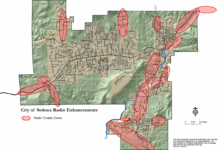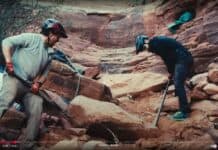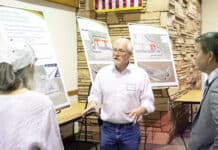Streetlights could shine in West Sedona by June 2009, giving Hwy. 89A motorists a chance to see pedestrians after dark and reducing fatal collisions, but only if Sedona City Council approves and scientific studies justify the cost.
Larson Newspapers
Streetlights could shine in West Sedona by June 2009, giving Hwy. 89A motorists a chance to see pedestrians after dark and reducing fatal collisions, but only if Sedona City Council approves and scientific studies justify the cost.
The recommendation to council, an 11th-hour compromise between dark sky conservationists, pedestrian safety watchdogs and government officials, calls for 10, 30-foot-tall, low-pressure sodium streetlights to be erected along a quarter mile stretch of highway near Andante Drive, a cross street where three men died in separate incidents after being hit at night by cars.
In all three cases, drivers stated they were unable to see the victim in the dark until the last minute.
The cost of installing the lights was estimated at roughly $265,000 to be paid using federal highway safety funds administered by the Arizona Department of Transportation.
The recommendation was just one of several from the Hwy. 89A Pedestrian Safety Advisory Panel that convened at City Hall on Wednesday, April 9.
Other recommendations include reducing the speed limit on Hwy. 89A from 40 mph to 35 mph, installing a traffic light and crosswalk at Andante Drive, and erecting a series of roadside barriers and medians from Airport Road to Dry Creek Road that force pedestrians to cross Hwy. 89A at specific intersections.
“I’m pretty happy we finally came to a consensus where we’re looking at the whole corridor, with lighting in small areas, and we can start studying barriers,” Chuck Gillick, chief ADOT traffic engineer for the Northern Region, said after the meeting.
Not every committee member approved.
Cliff Ochser, owner of Evening Sky Tours, a local business that offers guided tours of the city’s starry skies via telescope, said streetlights were not justified by proper studies.
Other safety recommendations should be implemented first, he said.
Sedona City Manager Eric Levitt reacted sternly, urging the committee to adopt the streetlight compromise as its consensus position. Ochser’s objections could be noted in the final report, he said.
“I’m not going to let one opinion hold up these recommendations,” Levitt said. “The studies have been done.”
Reduced visibility was the leading cause of at least three fatalities on dark stretches of Hwy. 89A in the last seven years, Sedona Chief of Police Joe Vernier said. In every case, crash investigators concluded drivers travelling at reduced speeds were nevertheless unable to see victims after dark.
“The data is there,” Vernier said.
Doug Blackwell, a local photographer and retired electrical engineer who worked with Levitt to fashion the compromise, agreed. Fatalities near Andante Drive justify lights there, he said.
“This committee has done its due diligence,” said Jennifer Wesselhoff, Sedona Chamber of Commerce president and CEO. “Let’s use a little common sense,”
Council could consider the recommendations in May and possibly as late as June, Levitt said.
New lights could be designed and implemented “within 12 to 16 months” after council votes to approve them, Gillick said.
Next, the lights must pass a cost-benefit analysis by ADOT engineers to qualify for federal funding.
“We still have to justify what we do will create an improvement [in safety],” Gillick said.
ADOT can use federal highway safety improvement funds to pay for installation, but the cost to maintain low-pressure sodium lights favored by dark sky advocates would fall to the city.
ADOT’s original proposal to erect 76 streetlights from Dry Creek Road to Airport Road outraged Keep Sedona Beautiful, a local conservation group, and hundreds of its members back in August.
KSB applied political pressure, persuading council to suspend its unanimous August vote to approve the continuous lighting plan.
At the suggestion of Councilman Rob Adams, council then directed Levitt to form a committee of residents to study the issue. The committee started meeting in November.
A draft of the committee’s initial recommendations was withdrawn in February after Levitt decided he could not sign his name to it. The February report recommended no streetlights.
Other key members of the committee, like Vernier and Sedona Fire District Fire Chief Matt Shobert, also objected to the February report, prompting the committee to revise its recommendations.
Greg Ruland can be reached at
282-7795, Ext. 127, or e-mail
editor@larsonnewspapers.com





















